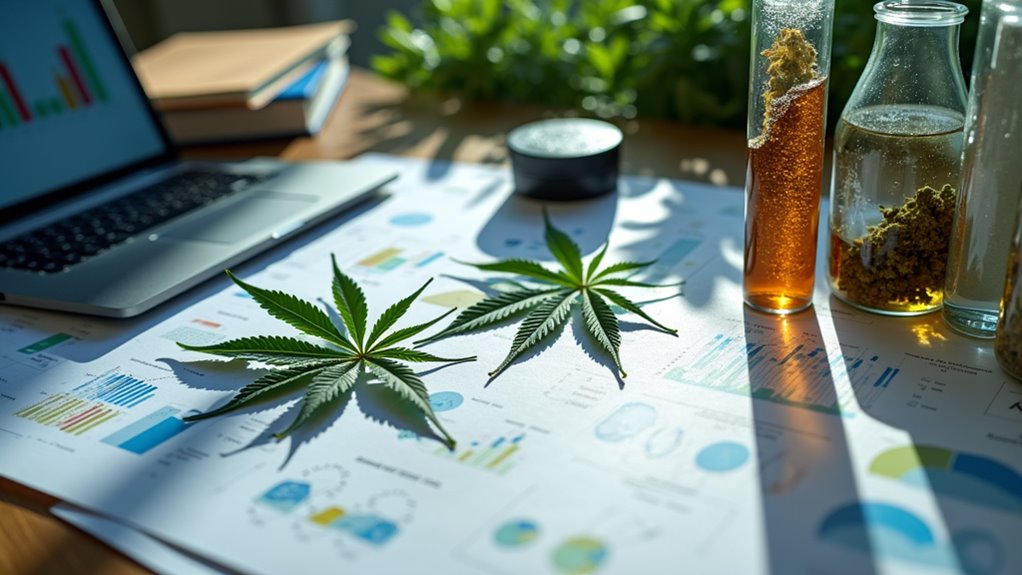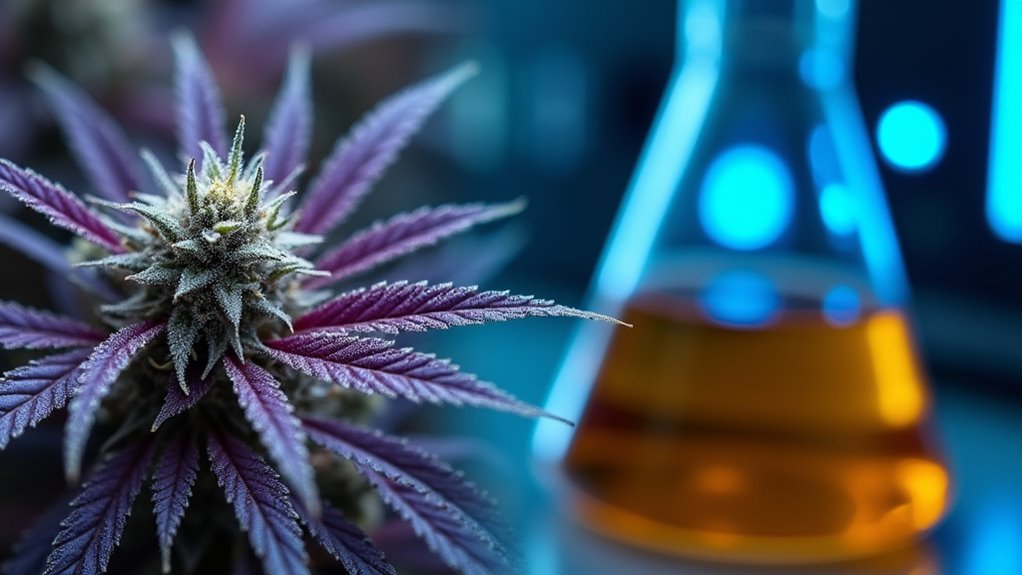Recent marijuana addiction research (2020-2025) shows you’re facing significant shifts in usage patterns and risks. You’ll find dramatic increases among adults of middle years, while young adults (21-25) maintain the highest usage at 23%. The data reveals concerning trends in delta-8 THC exposure, with an 80% rise in poison center reports. Mental health correlations prove especially troubling, as cannabis users face 29% higher depression risks. These evolving patterns signal critical developments ahead in addiction science and public health.
Emerging Usage Patterns Across Age Groups

Three distinct trends characterize the emerging patterns of marijuana use across generations over the past decade. Initially, adults aged 35-50 have shown nearly doubled usage rates between 2020-2021, with the 26-39 age group experiencing the most substantial increase of 5.9 percentage points. Past-year cannabis use among this age group has risen dramatically from 12.6% to 24.9% between 2011 and 2021.
Second, young adults (21-25) now represent the highest usage demographic at 23%, marked by increased frequency and stress-coping motivations. Notably, daily cannabis consumption among Millennial users continues to grow despite overall declining trends. Third, underage users (18-20) maintain the second-highest prevalence at 21.8%, with 53% reporting initial use between ages 12-17.
You’ll find these patterns complicated by evolving consumption methods, particularly the rise in edibles consumption among younger users, and concerning rates of polysubstance co-use with alcohol and nicotine. Mental health disparities increasingly correlate with these usage patterns, especially among young adult consumers.
Rising Addiction Rates and Key Risk Indicators

While marijuana legalization continues to expand across the United States, addiction rates exhibit complex patterns influenced by multiple risk factors. You’ll find that socioeconomic disparities and multi-generational impacts shape vulnerability across demographics, with notable concerns emerging in both youth and aging populations. Research indicates that 76 percent of Americans consider marijuana less harmful than tobacco use. Modern research shows that cannabis use disorders affect roughly 4.5 million Americans aged 12 or older.
| Risk Factor | Key Indicator |
|---|---|
| Age Group | 40% of high school students report lifetime use |
| Gender | Men show 15% higher usage rates than women |
| Generation | Millennials lead with 51% lifetime usage |
| Mental Health | Early use increases psychosis risk |
| THC Potency | Higher concentrations elevate dependency risk |
The data reveals concerning trends: approximately 3,300 adolescents initiate marijuana use daily, while adults over 50 increasingly turn to cannabis for medical purposes. These patterns, combined with rising THC potency and expanded accessibility, suggest a complex terrain of addiction risk that crosses generational boundaries.
Delta-8-THC: New Trends and Public Health Concerns

Recent trends in delta-8-THC consumption have sparked significant public health alarms across the United States. With an 80% increase in poison center reports from 2021-2022, you’ll find the scene particularly concerning due to inadequate manufacturing standards and labeling transparency. Since 2020, the rapid rise of delta-8 has created a thriving market surge in states like Texas, Florida, and Tennessee.
Key concerns include:
- Unregulated production leading to contamination risks and inconsistent THC concentrations
- Aggressive marketing tactics targeting youth through candy-like products and online platforms
- 77% of exposure cases involving edibles, with the U.S. South accounting for two-thirds of incidents
- Limited oversight resulting in misleading product claims and insufficient safety data
The patchwork of state regulations complicates enforcement efforts, though states with delta-8 bans report fewer exposures. Without standardized testing protocols and federal oversight, you’re witnessing a growing public health challenge that demands immediate attention. Children under age six represent nearly half of all non-critical and critical care unit admissions related to delta-8 exposures.
Mental Health Connections and Vulnerability Factors
Research reveals that if you’ve experienced early trauma, you’ll face a considerably higher risk of developing both cannabis dependence and depression.
Recent studies found lower brain activation during working memory tasks among heavy cannabis users, highlighting another potential vulnerability factor.
You’re five times more likely to experience depression if you’re a young woman using cannabis daily, creating a dangerous cycle of self-medication and worsening mental health.
Your risk factors compound when early-life adversity intersects with cannabis use, as trauma alters brain chemistry in ways that make you more susceptible to both substance dependency and mood disorders. The rise in these vulnerabilities is particularly concerning given that modern cannabis contains higher THC content than ever before.
Depression and Dependence Links
Evidence from extensive meta-analyses reveals a troubling connection between cannabis use and depression, with users facing a 29% higher risk compared to non-users. Studies examining comorbid substance use show particularly concerning outcomes for adolescents, with neural mechanism interactions potentially disrupting critical developmental periods.
Research highlights several key vulnerability factors:
- Daily cannabis use in teenage girls correlates with 5× greater depression odds by adulthood
- Near-daily use affects 15% of adults already struggling with depression
- Early exposure drastically disrupts neurodevelopment, especially before the teenage years
- Bidirectional relationships exist where depression and cannabis use mutually reinforce each other
These findings emphasize the need for targeted interventions, particularly among young users where the risk of developing both depression and cannabis dependence is substantially higher. The growing concerns are supported by data showing daily cannabis use increased by 40% from 2002 to 2017.
Early Trauma Raises Risk
While childhood trauma alone can devastate mental health, its interaction with cannabis use creates a particularly dangerous spiral of vulnerability. Environmental factors and family dynamics play essential roles in shaping addiction risk trajectories.
| Risk Factor | Impact | Outcome |
|---|---|---|
| Early Trauma | Disrupts emotional regulation | 27% higher use likelihood |
| Family History | Genetic predisposition | Increased addiction risk |
| Socioeconomic Status | Limited mental health access | Higher dependency rates |
| Peer Networks | Social pressure | Normalized heavy use |
You’ll find that trauma survivors often turn to cannabis as a coping mechanism, particularly when faced with limited mental health resources. Research shows this self-medication pattern intensifies when combined with genetic vulnerabilities and economic stressors. The intersection of childhood adversity and cannabis use during brain development can dramatically alter your neural pathways, potentially leading to long-term cognitive deficits and reduced life outcomes. Regular cannabis use during adolescence can lead to a significant decline in IQ points that persists into adulthood.
Therapeutic Applications and Self-Treatment Demographics
Three distinct therapeutic approaches have emerged in addressing cannabis use disorder (CUD): CB1 receptor modulation, THC-CBD combinations, and enzyme inhibition strategies.
When examining chronic condition demographics and self-medication motivations, you’ll find significant shifts in usage patterns, particularly among individuals over the golden years. Current estimates show 16.3 million people meet the criteria for CUD in the United States.
Adults in their twilight years represent the fastest-growing demographic of cannabis users, primarily seeking relief from pain and sleep issues. Chronic conditions like anxiety, depression, and HIV/AIDS drive therapeutic self-treatment decisions. Pain management remains the predominant motivation across all life stages.
New compounds like AEF0117 and nabiximols show promise in managing withdrawal symptoms. Current research indicates CBD-rich formulations effectively reduce anxiety and withdrawal symptoms without intoxicating effects, while behavioral interventions like CBT continue to form the backbone of CUD treatment protocols.
Research Methodologies and Data Collection Advances
Recent advancements in cannabis research methodologies have revolutionized our understanding of marijuana addiction and treatment outcomes. You’ll find extensive data collection efforts through initiatives like NIDA’s Medicinal Cannabis Registry and the ABCD Study®, which are transforming cannabis industry data gathering practices.
| Research Tool | Primary Focus | Key Outcome |
|---|---|---|
| NIDA Registry | Product Composition | Treatment Effectiveness |
| ABCD Study® | Brain Development | Risk Factors |
| MTF Survey | Usage Patterns | Trend Analysis |
| HCP Data | Neural Activity | Cognitive Impact |
These methodological advances strengthen cannabis product regulation efforts while providing unprecedented insights into usage patterns. From fMRI-based neuroimaging to standardized diagnostic tools, you’re seeing more sophisticated approaches to studying addiction. The integration of longitudinal cohort studies with biological markers has particularly amplified our ability to distinguish between acute and chronic use impacts, supporting evidence-based intervention strategies.
Policy Challenges in the Current Landscape
The fragmented cannabis policy terrain across states creates significant regulatory gaps and enforcement challenges, with 24 states permitting adult use while 26 maintain criminalization.
Recent legislation like New Jersey S.4154 aims to discourage unregulated markets by making purchases from unlicensed sources punishable through significant fines.
You’ll find these disparities particularly evident in prevention efforts, where some states implement strict THC potency limits and rigorous testing requirements while others lack basic consumer protections.
The tension between market forces pushing for expansion and public health concerns advocating for tighter controls has resulted in inconsistent standards, making it difficult to establish unified approaches to addiction prevention and treatment. The lack of federal reform progress continues to hamper the industry, with the SAFER Banking Act failing to advance in Congress and creating ongoing financial obstacles for cannabis businesses.
Regulatory Gaps Across States
Despite widespread momentum in the direction of cannabis reform, significant regulatory gaps and inconsistencies across states create a complex patchwork of laws that challenge both consumers and policymakers. You’ll find stark enforcement discrepancies between neighboring jurisdictions, with some states imposing jail time while others opt for civil penalties. The landscape is particularly complex with twenty-one states now permitting full recreational and medicinal use. As of February 2025, thirty-nine states have established medical cannabis programs with varying patient registry requirements.
Key regulatory oversight gaps are evident in:
- THC content limits varying dramatically – from Kentucky’s 35% cap on raw cannabis to Iowa’s strict 4.5g/90-day medical restriction
- Medical program disparities, with states like Kansas limiting THC to 0.3% while others allow much higher concentrations
- Enforcement approaches ranging from Iowa’s 6-month imprisonment to Texas’s proposed $500 fine
- Legislative deadlock in states like Pennsylvania, where reform bills face continued committee delays
These inconsistencies create confusion and highlight the need for standardized regulatory frameworks.
Prevention Vs Market Forces
Growing tensions between prevention efforts and market forces create significant policy challenges in cannabis regulation. You’ll find that while school-based interventions show moderate success, they’re increasingly undermined by market-driven normalization and expanding legal availability. Public health messaging struggles to compete with industry marketing, particularly as states prioritize economic goals over prevention funding.
Community coalitions and prevention programs face an uphill battle against retail expansion and high-potency products. While price regulations and THC caps aim to protect public health, they’re often weakened by compliance issues and gray market activity. Evidence suggests that current prevention strategies aren’t keeping pace with market evolution – traditional approaches become less effective as cultural perceptions shift toward/in the direction of acceptance. This misalignment between public health objectives and commercial interests continues to complicate policy implementation across jurisdictions.
Prevention Strategies and Future Directions
As marijuana legalization expands across jurisdictions, extensive prevention strategies have emerged alongside pivotal research priorities to address potential public health impacts. Evidence-based practices and multisector collaborations are shaping broad approaches to prevention, particularly focusing on youth protection and public health outcomes.
Key prevention strategies include:
- Integration of Marijuana Prevention Plus Wellness programs with school-based interventions
- Implementation of retail restrictions and THC content caps to limit accessibility
- Improvement of surveillance systems for tracking usage patterns and outcomes
- Development of youth-centric prevention through peer-based wellness promotion
These initiatives are supported by ongoing research priorities examining policy impacts, mental health comorbidities, and standardized impairment criteria. As you evaluate these developments, you’ll notice an increasing emphasis on equity-focused prevention and evidence-driven approaches to address emerging challenges in cannabis control.
Frequently Asked Questions
How Does Secondhand Marijuana Smoke Affect Non-Users in Shared Living Spaces?
If you’re exposed to secondhand marijuana smoke in shared spaces, you’ll face serious health risks through passive secondhand exposure. Ambient air quality monitoring shows that toxic particles remain 6 times above EPA limits even 12 hours after smoking.
You’re at risk for immediate symptoms like anxiety and respiratory issues, plus long-term cardiovascular problems with a 20-30% increased stroke risk. The smoke’s particulate matter reaches 10 times the concentration of unhealthy wildfire smoke.
Can Workplace Drug Testing Distinguish Between CBD and THC Consumption?
No, workplace drug tests can’t reliably distinguish between CBD and THC consumption. Standard urine screening limitations mean these tests only detect THC metabolites, not CBD specifically.
Even if you’re using legal CBD products, you could fail a drug test if they contain trace amounts of THC that accumulate in your system. Current workplace policies typically don’t differentiate between THC sources, so you’ll need to be cautious when using CBD products before drug screenings.
What Role Does Genetics Play in Individual Tolerance to Marijuana?
Your genetic predisposition markedly influences how you respond to marijuana. Your DNA affects your endocannabinoid system function, metabolism speed, and receptor sensitivity.
If you carry certain gene variants like CYP2C9, you’ll metabolize THC more slowly, potentially experiencing stronger effects. Your genetics also impact how quickly you develop tolerance and your susceptibility to adverse reactions. These inherited traits can make you either more sensitive or resistant to marijuana’s effects.
How Do Different Marijuana Strains Impact Addiction Potential and Withdrawal Symptoms?
Your risk of addiction markedly increases with higher strain potency levels, as concentrated THC content directly affects your brain’s metabolizing techniques.
You’ll face more severe withdrawal symptoms from potent strains, particularly those exceeding 15% THC. When you regularly use high-THC cannabis, you’re more likely to experience intensified anxiety, insomnia, and irritability during withdrawal.
Your body develops tolerance faster to stronger strains, potentially accelerating the addiction cycle.
Does Combining Marijuana With Prescription Medications Increase Health Risks Significantly?
Yes, combining marijuana with prescription medications considerably increases your health risks through dual medication interactions. You’re particularly vulnerable when using antidepressants, anticoagulants, or immunosuppressants with cannabis. THC and CBD can interfere with how your body processes these medications, leading to unintentional overdose risks or reduced drug effectiveness.
You’ll face heightened dangers when mixing marijuana with benzodiazepines or opioids, as these combinations can cause severe respiratory depression and cardiovascular complications.

